Kirby Larson's Blog, page 20
February 25, 2014
From the Office of the Future of Reading
Please join me in welcoming today's guest blogger, Tammy Langeberg. Tammy has been a teacher for 26 years in Jeffco, Colorado, 15 of those as a school librarian. She is National Board Certified Librarian and a Colorado Highly Effective School Librarian. Tammy is the co-chairperson of the Colorado Children’s Book Award through CCIRA. She loves her job and loves to match the right books with the right person (teachers and students).
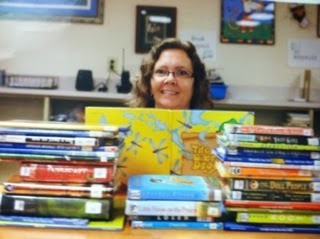 Tammy captured in her natural habitat
Tammy captured in her natural habitatQuality picture books, read aloud, help students understand the craft of writing. Back when I started teaching we called mentor texts something different, but it is about finding the right book for that teachable moment. Here are some mentor texts I have found to work well.

The Hello, Goodbye Window by Norton JusterThis book is a wonderful example of a childhood memoir. It tells the story of a child visiting his grandparents and the tradition of greeting each other at the window. This slice of life can prompt students to develop their own memoirs using simple daily life memories.
I Wanna Iguana and I Wanna New Room by Karen Kaufman Orloff
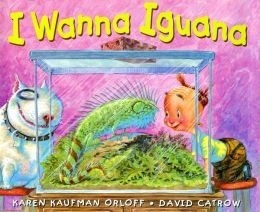
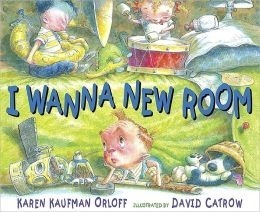
These titles are the perfect mentor texts for persuasive writing. In the first, Alex uses his writing skills to lobby for a pet iguana. In the sequel, he does the same, this time asking for his own room after having to share a room with his brother. The books are funny and Alex always gets what he wants!
Spoon by Amy Krouse Rosenthal
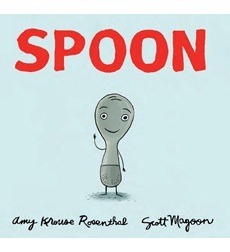 This book personifies an object in a funny story about not fitting in and self doubt. Spoon starts out thinking everyone else is so much better than him, but eventually finds out he is pretty great, too. Spoon can help students see how even the most common object can make an interesting story.
This book personifies an object in a funny story about not fitting in and self doubt. Spoon starts out thinking everyone else is so much better than him, but eventually finds out he is pretty great, too. Spoon can help students see how even the most common object can make an interesting story. Rosenthal’s Exclamation Mark is also a wonderful example of personification with a dose of conventions.
Honestly, Red Riding Hood Was Rotten! by Trisha Speed Shaskan
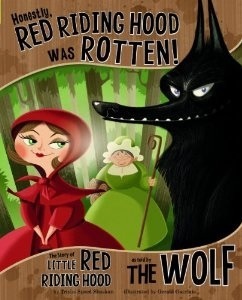
This fractured fairy tale is a great way to show point of view using a story most students recognize. The wolf explains his point of view in which he was not the bad guy as we would believe from the traditional story. There are other books in this series including Cinderella and Goldilocks with the same theme.
Bully by Laura Vaccaro Seeger
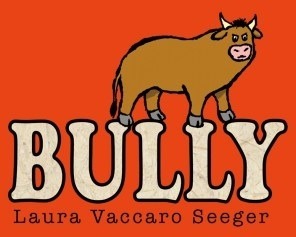
Bully is an almost wordless picture book which gets the point across about how bullies become bullies. If you do not share the end page at the start, you miss the whole meaning of the book. It is a great example of how characters can change.
This is a very short and targeted list of books I have used for mentor texts. I could go on and on about many more, but I selected these to share a variety of crafts and books to help students be inspired and to know that they can write about anything.
I would love to hear about what you use in your writing classes because sharing makes us all better teachers...and our students better learners.
Thank you Tammy, for sharing such a great list of mentor texts and ways they can be used to inspire student writings!
Published on February 25, 2014 05:30
February 21, 2014
Friend Friday
I did just about everything wrong as a new writer. I won’t bore you with all my mistakes; just join the Society of Children’s Book Writers and Illustrators so you can avoid them. But the one thing I did do right was read. I read like I used to as a kid – forgetting my chores and just about everything else. Though I was writing mainly picture book manuscripts back then, I was mad for middle grade fiction.
One of the first writers to hook me was Jamie Gilson.
I don’t remember in which order I read her books, but suspect I started with Thirteen Ways to Sink a Sub, working my way through 4B Goes Wild, You Can’t Catch Me, I’m the Gingerbread Man, etc. (she has over 20 titles). Her writing was fun and funny and fresh and, though she kept a page-turning clip, she also made me care tremendously about the characters. I read and re-read her work as I puzzled out what it mean to write a MG novel.
Fast forward a few (over twenty!) years: late in 2013, four Nerdy Book Club folks -- Franki Sibberson, Katherine Sokolowski, Colby Sharp and Chris Lehman – had a Twitter conversation that morphed into Nerdultions: the commitment to do one thing every day for 50 days. I signed on, committing to write letters to 50 of the people who have had an impact on my writing life.*
One of my first letters had to be to Jamie Gilson but I could find no contact information except an email address. And I wanted to send a letter. When I discovered that she would have a new book out in December (My Teacher is an Idiom) from Clarion, I wrote her care of them.
Within a few weeks, I got the sweetest email from her: How is it possible that I could ever have had any influence over you and your wonderful words? Though you say so, I find it hard to believe. But, I thank you for writing to tell me. Her reply also included this line: It’s lovely that we know each other through our books, though Hattie and Hobie are a most unlikely pair to have introduced us.
I nearly fell off my office chair. I quickly swiveled around and pulled my dog-eared copy of Thirteen Ways to Sink a Sub from the shelf. The book’s main character is named Hobie Hanson.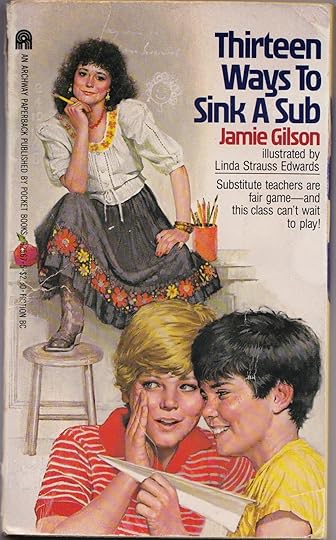 My much-read copy of Thirteen Ways to Sink a SubHobie Hanson. Hobie Hanson!!!
My much-read copy of Thirteen Ways to Sink a SubHobie Hanson. Hobie Hanson!!!
For my latest book, Duke, I had wrestled and wrestled, searching for a 40s moniker for the main character. One day, the perfect name came to me – and guess what it was?
Until Jamie’s email, I had believed Hobie’s name came out of nowhere. But now I know it came from the spot in my heart that holds dear those books that made an indelible impression on this fledgling writer.
But what if Jamie saw it differently? I had to confess this “coincidence” to her. Here is her delightfully kind reply:
I, too, am amazed. And, as Aunt Ivy might say, I’m tickled pink, pleased as punch and proud as all get out. Okay, Aunt Ivy might not have acknowledged being pleased and proud, but I do. . . .Now with substantial proof, I’m willing to believe that I’ve had at least some sub-conscious influence on what you’ve written.Onward!Jamie
Onward, indeed.
*True confession: I have not kept up with the 50 days in a row part of the Nerdlution pledge but I have gotten over breaking that rule.
One of the first writers to hook me was Jamie Gilson.

I don’t remember in which order I read her books, but suspect I started with Thirteen Ways to Sink a Sub, working my way through 4B Goes Wild, You Can’t Catch Me, I’m the Gingerbread Man, etc. (she has over 20 titles). Her writing was fun and funny and fresh and, though she kept a page-turning clip, she also made me care tremendously about the characters. I read and re-read her work as I puzzled out what it mean to write a MG novel.
Fast forward a few (over twenty!) years: late in 2013, four Nerdy Book Club folks -- Franki Sibberson, Katherine Sokolowski, Colby Sharp and Chris Lehman – had a Twitter conversation that morphed into Nerdultions: the commitment to do one thing every day for 50 days. I signed on, committing to write letters to 50 of the people who have had an impact on my writing life.*
One of my first letters had to be to Jamie Gilson but I could find no contact information except an email address. And I wanted to send a letter. When I discovered that she would have a new book out in December (My Teacher is an Idiom) from Clarion, I wrote her care of them.
Within a few weeks, I got the sweetest email from her: How is it possible that I could ever have had any influence over you and your wonderful words? Though you say so, I find it hard to believe. But, I thank you for writing to tell me. Her reply also included this line: It’s lovely that we know each other through our books, though Hattie and Hobie are a most unlikely pair to have introduced us.
I nearly fell off my office chair. I quickly swiveled around and pulled my dog-eared copy of Thirteen Ways to Sink a Sub from the shelf. The book’s main character is named Hobie Hanson.
 My much-read copy of Thirteen Ways to Sink a SubHobie Hanson. Hobie Hanson!!!
My much-read copy of Thirteen Ways to Sink a SubHobie Hanson. Hobie Hanson!!!For my latest book, Duke, I had wrestled and wrestled, searching for a 40s moniker for the main character. One day, the perfect name came to me – and guess what it was?
Until Jamie’s email, I had believed Hobie’s name came out of nowhere. But now I know it came from the spot in my heart that holds dear those books that made an indelible impression on this fledgling writer.
But what if Jamie saw it differently? I had to confess this “coincidence” to her. Here is her delightfully kind reply:
I, too, am amazed. And, as Aunt Ivy might say, I’m tickled pink, pleased as punch and proud as all get out. Okay, Aunt Ivy might not have acknowledged being pleased and proud, but I do. . . .Now with substantial proof, I’m willing to believe that I’ve had at least some sub-conscious influence on what you’ve written.Onward!Jamie
Onward, indeed.
*True confession: I have not kept up with the 50 days in a row part of the Nerdlution pledge but I have gotten over breaking that rule.
Published on February 21, 2014 05:30
February 20, 2014
From the Office of the Future of Reading
I am so tickled to welcome Niki Barnes as my guest blogger today. She is a second grade teacher at a rural school in Dorr Michigan. She loves to blog about books at daydreamreader.com She is also a proud member of the Nerdy Book Club and you can find her talking about books on Twitter.
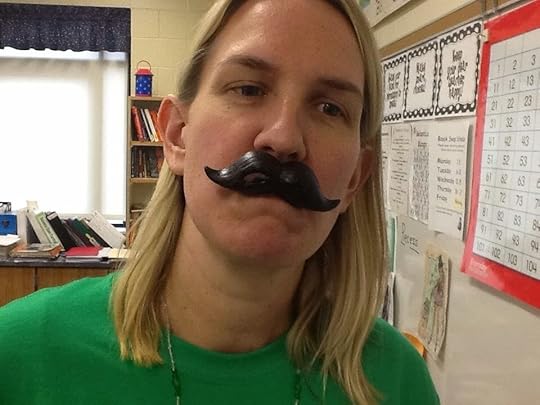 Niki Barnes
Niki Barnes
This is my second year teaching second grade and I feel like my mission is to make reading fun. In fact, I still have fond memories of my third grade teacher reading aloud James and The Giant Peach and my fourth grade teacher reading Tales of a Fourth Grade Nothing. I’m hoping that my students will think back to second grade and remember the funny and fabulous books that I read to them aloud.
So I mustache you a question...What are your favorite read aloud books? My students and I love mustache themed books! Here are some of our favorites:
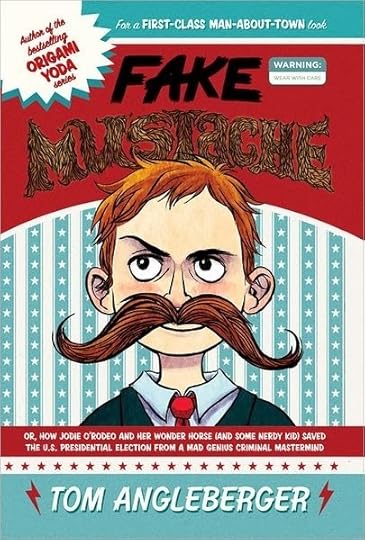
Fake Mustache by Tom Angleberger
A crazy, hilarious chapter book about mimes, clowns, novelty toys, washed up TV stars who ride horses and yodel and of course a kid with a fake mustache who is trying to take over the world. How could students not love it? I highly recommend this book as a read aloud! My students ask me to read more every time I stop reading. I hear a lot of “Aww! Do you have to stop reading?” But I think the biggest shocker was when I was reading it aloud as my students cleaned out their desks. Usually cleaning out our desks is a wild and rumpus affair but instead they were mesmerized by the book and listening intently while cleaning….that is the power of the character Fako Mustacho.
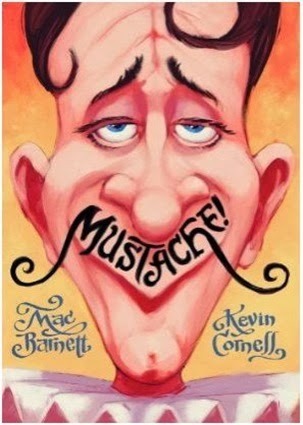
Mustache by Mac Barnett and Kevin CornellThis is a fun picture book about a King that loves himself more than his subjects. The kingdom is crumbling and the people in the kingdom decide to get even in a fun and clever way. The pictures in this book are so funny and detailed. I made sure the students had a lot of time to look at the laugh out loud pictures as I was reading it aloud.
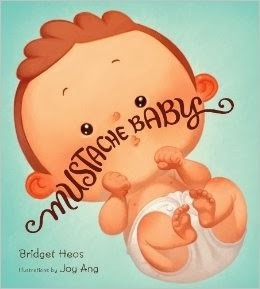
Mustache Baby by Bridget Heos and illustrated by Joy Ang
I can sell this book easily to my students just based on the title and cover. The story is clever, funny and entertaining. Will the mustache lead the baby to work for good or evil? Pure entertainment...expect lots of laughter!
And of course after you read all these Mustache themed books a Fake Mustache party is in order. You know you have a hit party on your hands when students keep asking you every five minutes…"When is our Fake Mustache party?” And for me the pictures of my students in their grape flavored wax mustaches = priceless. We might not be taking over the world like our favorite character Fako Mustacho but we are having a blast reading...and that is what it is all about.
au contraire, Niki -- I can absolutely imagine you and your students taking over the world! In fact, I hope that happens. Then you can arrange for every classroom to experience fun and rollicking read-alouds.
 Niki Barnes
Niki BarnesThis is my second year teaching second grade and I feel like my mission is to make reading fun. In fact, I still have fond memories of my third grade teacher reading aloud James and The Giant Peach and my fourth grade teacher reading Tales of a Fourth Grade Nothing. I’m hoping that my students will think back to second grade and remember the funny and fabulous books that I read to them aloud.
So I mustache you a question...What are your favorite read aloud books? My students and I love mustache themed books! Here are some of our favorites:

Fake Mustache by Tom Angleberger
A crazy, hilarious chapter book about mimes, clowns, novelty toys, washed up TV stars who ride horses and yodel and of course a kid with a fake mustache who is trying to take over the world. How could students not love it? I highly recommend this book as a read aloud! My students ask me to read more every time I stop reading. I hear a lot of “Aww! Do you have to stop reading?” But I think the biggest shocker was when I was reading it aloud as my students cleaned out their desks. Usually cleaning out our desks is a wild and rumpus affair but instead they were mesmerized by the book and listening intently while cleaning….that is the power of the character Fako Mustacho.

Mustache by Mac Barnett and Kevin CornellThis is a fun picture book about a King that loves himself more than his subjects. The kingdom is crumbling and the people in the kingdom decide to get even in a fun and clever way. The pictures in this book are so funny and detailed. I made sure the students had a lot of time to look at the laugh out loud pictures as I was reading it aloud.

Mustache Baby by Bridget Heos and illustrated by Joy Ang
I can sell this book easily to my students just based on the title and cover. The story is clever, funny and entertaining. Will the mustache lead the baby to work for good or evil? Pure entertainment...expect lots of laughter!
And of course after you read all these Mustache themed books a Fake Mustache party is in order. You know you have a hit party on your hands when students keep asking you every five minutes…"When is our Fake Mustache party?” And for me the pictures of my students in their grape flavored wax mustaches = priceless. We might not be taking over the world like our favorite character Fako Mustacho but we are having a blast reading...and that is what it is all about.
au contraire, Niki -- I can absolutely imagine you and your students taking over the world! In fact, I hope that happens. Then you can arrange for every classroom to experience fun and rollicking read-alouds.
Published on February 20, 2014 05:30
February 19, 2014
Wednesday Wisdom
When life seems hard, the courageous do not lie down and accept defeat. Instead, they are all the more determined to struggle for a better future.
Queen Elizabeth II
Queen Elizabeth II
Published on February 19, 2014 05:30
February 18, 2014
From the Office of the Future of Reading
I am so pleased to welcome Jennifer Ochoa as today's guest blogger. Jennifer reads and writes and shares BOOKS, BOOKS, BOOKS with the eighth graders in her classes at MS 324 in NY, NY. When she’s not hanging out with eigth graders, she’s usually hanging out with grown-ups, but still talking about reading, writing and books. In a recent move, more than half the boxes were books! You can follow her on Twitter. She’d love to hear your latest book love, or share a recommendation from her own reading life. Jennifer gets a ginormous gold star in my book because she wrote this post while packing up her apartment to move! That's dedication for you.
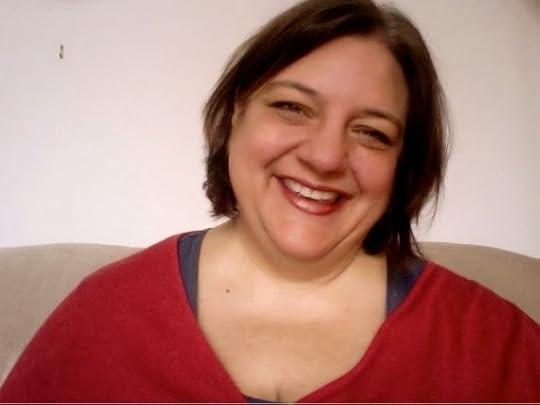 Jennifer Ochoa
Jennifer Ochoa“Head’s Up!”: Strategies for Managing New Genres
Now that it’s February, the groans and eye-rolls have ceased when I say, “Get out your books and LET’S READ!” Even the grouchiest readers have found a reading niche in our classroom. Independent Reading is a cozy, book-filled time. Now it’s time to up our game a bit.
When we came back after winter break, everyone made Reading Resolutions. Because 8th graders sometimes copy motivation, I wasn’t surprised many people decided they needed to “Read more non-fiction” and “Try a new genre,” which were my resolutions. It’s possible to accomplish our goals, but moving out of a comfort zone you’ve just found isn’t easy. Recently, many of our reading conferences have been “Getting started” conferences for new, more complicated, books and unfamiliar genres.
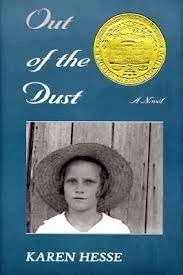 One way I’ve found getting started on new genres feels possible for a kid is by having “Head’s Up!” conversations with me. In these conversations (and on the corresponding reminder charts on the wall), I try to craft multiple ways into a genre that anticipate aspects of that genre that might confuse a reader. These conversations offer “head’s up” tips that can help a kid manage, even when I’m not there. Below are examples we’ve used as a class when we recently started reading Karen Hesse’s novel in verse, Out of the Dust:
One way I’ve found getting started on new genres feels possible for a kid is by having “Head’s Up!” conversations with me. In these conversations (and on the corresponding reminder charts on the wall), I try to craft multiple ways into a genre that anticipate aspects of that genre that might confuse a reader. These conversations offer “head’s up” tips that can help a kid manage, even when I’m not there. Below are examples we’ve used as a class when we recently started reading Karen Hesse’s novel in verse, Out of the Dust:Heads Up! When you read HISTORICAL FICTION, pay attention to, or remember that:
It is a regular story about regular people. The characters have many of the same feelings, ideas, and conflicts that you’ve read about in realistic fiction. The big difference is that these characters’ experiences are happening during a different time in history.
The time period in history, which is the setting, is important in this kind of story. Because the setting is so important, it is a good idea to be a bit familiar with that time and place in history. If you know a little about the real events of that time period, the characters’ experiences and daily lives won’t feel as confusing to you.
Because of the setting, there might be some confusing details. Sometimes the characters will say something or talk about a detail from life (like their clothes, or tasks they have to do), and the phrases and details will be unfamiliar. Remember, every time period has different slang, fashions, and details of life. Even though this might confuse you, that’s ok. Try to figure out what the character is talking about or referring to. If you can’t, ask someone. If no one is available to ask, read on and decide if you still understand what is happening in the story. Probably you will.
Heads Up! When you read a POETIC NOVEL, remember:
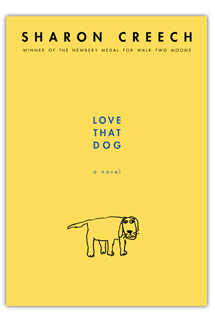
Each poem contains elements of the story about the characters, conflict, setting, theme or plot
Each poem can usually stand on its own as poem, but when you put all the poems together, they tell the whole story.
The author uses figurative language like metaphors and imagery to help us imagine the story, tell us what’s beneath the surface of the plot.
The “Head’s up” conferences are often enough to get readers started, feeling like they can manage the book on their own. Usually, kids are excited to try something new, they just worry they’ll be confused and have to abandon the book. These conversations help ease the worry, and empower the kids to read widely and challenge themselves. We have many “Head’s up” lists available in our classroom, so that whatever genre a reader might like to try, getting started feels possible.
Jennifer, what a thoughtful way to anticipate potential obstacles to readers as they explore different genres. I might have been able to finish Moby Dick in high school had you been my teacher!
Published on February 18, 2014 05:30
February 14, 2014
Friend Friday
I first met Rodman Philbrick through his moving novel, Freak the Mighty and have been a huge fan ever since. (if you haven't, be sure to read his historical novel, The Mostly True Adventures of Homer P. Figg). Rod and I caught up with each other at NCTE in November and I was delighted to learn he had a new book coming out in March and even more delighted when he agreed to participate in Friend Friday.
 Rodman Philbrick
Rodman Philbrick
Where do authors get their ideas? Surely that question was first posed about nine seconds after the first story teller finished telling the first story. Doubtless that first tale was spun in the dark, and shaped by the light of a fire.
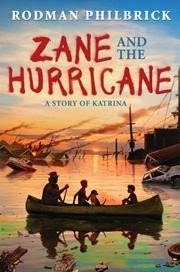
Every story starts somewhere, for sure, and in my case Zane and The Hurricane began in candlelight, during a hurricane, a very long time ago. Specifically Hurricane Carol, in late August of 1954. One of my earliest memories is of ‘camping out’ under the dining room table in South Weymouth, Massachusetts. My father, as salesman, and could not get home because a fourteen foot storm surge flooded Providence, Rhode Island and he was trapped in his hotel.
My 27 year old mother, fearing that a huge tree in the yard might come down on the house, gathered up her three little boys and sought refuge under the table. She had a two week old baby in her arms. That was my brand new brother Jonathan. My brother Philip was a toddler. I was three and a half. There is no fear in that blurry, often conjured memory, only the delight of the flickering candle and a sense of what a fine adventure it was, to be playing under a table with my mother and my little brothers.
I had no idea what a hurricane was, and doubt that Mom even mentioned the word, so as not to frighten us. Many years later, when variously named hurricanes began to batter Florida on an all-too regular basis, I thought it might be interesting to make up a story and honor my mother at the same time by calling it Hurricane Jane. The notion never got further than the rhyming title.
And then Katrina devastated New Orleans, turning it into what looked on TV like an unnatural Third World disaster, and I knew that had to be the story – it was too big to ignore - and somehow Jane became Zane, a boy from New Hampshire. He has little dog because, well, everything goes better with dogs. Right Kirby? Anyhow, that’s my story and I’m sticking to it!
I'm with you that dogs make a story, Rod! And I can't wait to read about Zane. Thanks for stopping by today.
 Rodman Philbrick
Rodman PhilbrickWhere do authors get their ideas? Surely that question was first posed about nine seconds after the first story teller finished telling the first story. Doubtless that first tale was spun in the dark, and shaped by the light of a fire.

Every story starts somewhere, for sure, and in my case Zane and The Hurricane began in candlelight, during a hurricane, a very long time ago. Specifically Hurricane Carol, in late August of 1954. One of my earliest memories is of ‘camping out’ under the dining room table in South Weymouth, Massachusetts. My father, as salesman, and could not get home because a fourteen foot storm surge flooded Providence, Rhode Island and he was trapped in his hotel.
My 27 year old mother, fearing that a huge tree in the yard might come down on the house, gathered up her three little boys and sought refuge under the table. She had a two week old baby in her arms. That was my brand new brother Jonathan. My brother Philip was a toddler. I was three and a half. There is no fear in that blurry, often conjured memory, only the delight of the flickering candle and a sense of what a fine adventure it was, to be playing under a table with my mother and my little brothers.
I had no idea what a hurricane was, and doubt that Mom even mentioned the word, so as not to frighten us. Many years later, when variously named hurricanes began to batter Florida on an all-too regular basis, I thought it might be interesting to make up a story and honor my mother at the same time by calling it Hurricane Jane. The notion never got further than the rhyming title.
And then Katrina devastated New Orleans, turning it into what looked on TV like an unnatural Third World disaster, and I knew that had to be the story – it was too big to ignore - and somehow Jane became Zane, a boy from New Hampshire. He has little dog because, well, everything goes better with dogs. Right Kirby? Anyhow, that’s my story and I’m sticking to it!
I'm with you that dogs make a story, Rod! And I can't wait to read about Zane. Thanks for stopping by today.
Published on February 14, 2014 05:30
February 13, 2014
From the Office of the Future of Reading
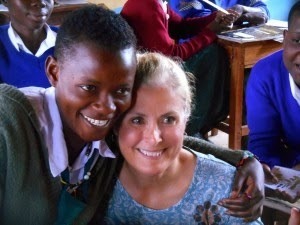 Michele with a friend
Michele with a friendMichele Torrey and I share a special bond: we both had the same fourth grade teacher, Mrs. B. (We won’t mention that Michele had Mrs. B several years after I did.) We get quite a kick out of the fact that we both turned out to be writers; Mrs. B does, too.
I am a huge fan of Michele’s writing and I am also a huge fan of her heart-project: Orphans Africa. This non-profit organization grew out of a trip to Tanzania “simply” to hike Mt. Kilimanjaro, but, once there, Michele found much bigger mountains to climb. AIDS and malaria has left over 2 million orphans in Tanzania, many of them being raised by grandmothers who do not have access so services that men do. In one of the poorest countries in the world, over one half of the population is under age 18.
Instead of saying, "Oh, how awful," Michele, her husband Carl Gann, and Elizabeth De Guzman, rolled up their sleeves. They saw two immediate needs to be addressed: education for the orphans, and empowerment for the widows.
 Carl
Carl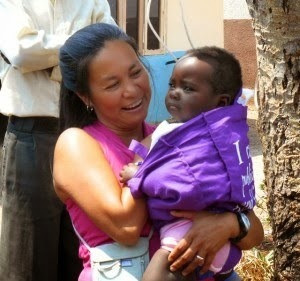 Liza
LizaHere is one secondary school prior to Orphans Africa’s involvement:

Here is the school after OA joined forces with the village:

In terms of empowering widows, OA has provided microloan funds to enable the widows (widows are often required to turn over their home and belongings to their husband’s family) to start small “pharmacies,” small basket weaving “businesses,” and even piggeries, to grow meat for the family and to sell.
The reason I am sharing this with you in a spot usually reserved for From the Office of the Future of Reading is that, in December, I made a gift in honor of all of this school year's guest teacher/librarian bloggers, which enabled OA to buy much-needed library books. So just by being a guest blogger, you are helping to connect kids and books – in Africa!
If you are moved by Michele’s efforts through Orphans Africa, (and how could you not be if you watch this video) and you live in the Puget Sound region, consider supporting the annual fundraiser auction, coming right up on March 8, 2014. Don’t live in the northwest? No worries! You can bid for some items on-line!
Or you can simply donate here.
Asante.
Published on February 13, 2014 05:30
February 12, 2014
Wednesday Wisdom
The only gift is a portion of thyself.
Ralph Waldo Emerson
Ralph Waldo Emerson
Published on February 12, 2014 05:30
February 11, 2014
From the Office of the Future of Reading
Please join me in welcoming today's guest blogger, Carrie Gelson. Carrie teaches at a small inner city school in beautiful Vancouver, British Columbia. She shares her love for books on the blog There’s a Book for That and highlights the learning and book love in her Grade 2/3/4 classroom on the blog Curiosity Racers. You can also find her on Twitter.
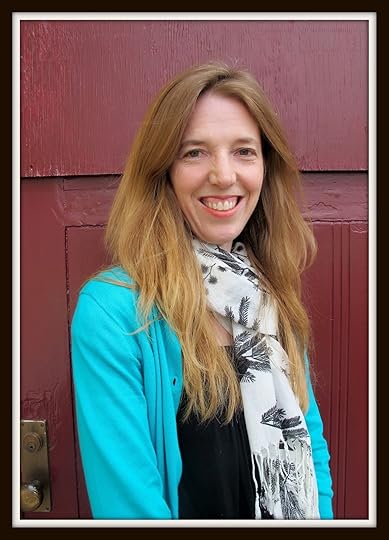
As a primary teacher, my biggest priority is growing readers. I know there is much book love inside of my classroom, but I have always wanted to do more to support families to help their children become lifelong readers. Last June, I had the opportunity to offer a literacy workshop for parents and caregivers at my school. I had the pleasure of spending a morning with families interested in learning more about how to incorporate reading and literacy activities into their daily lives with their children. The workshop was called: Celebrating the Love of Reading.
I made a flexible agenda and had numerous reference charts available. But the most important things I brought to the workshop were bins and bins of my favorite books (all genres and formats) and my enthusiasm about the importance of daily reading.
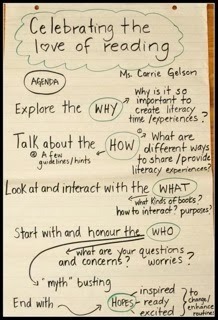
We began with this message: Your job as parents/caregivers is not to teach your child how to read (we do this at school) but instead to help encourage your child to want to read. A collective "phew" could be felt in the room. Once the pressure to improve their child's reading skills was off the table, parents were able to hear me when I explained that their role was to help create access to books (big cheers for school and public libraries), to make time in daily routines, to be a model (let them see you reading) and to be an active participant.
I also told parents that I needed to scare them a little bit. We talked about the summer slide and how children who did no reading over the summer would return to school in the fall behind where they were in June. Yet, if regular (ideally daily) reading was happening over the summer, their child's reading skills would have actually improved.
We had an important discussion about why children needed to be reading. Parents commented that they hadn't really thought about how many things solid reading skills supported.
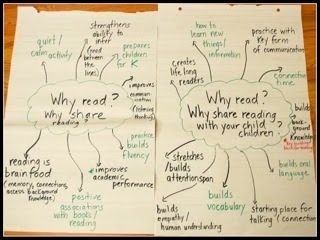 We spent a lot of time discussing the variety of ways we could share literacy experiences at home. I had a long list and modeled with a wide variety of books. I had some Grandpas in complete hysterics when I shared a guessing book about animal behinds (Tushes and Tails by Stephane Frattini). Parents who were not confident with their English skills or their reading fluency got very excited about audio books (I played a few during the workshop) and the idea of “telling” a wordless book together.
We spent a lot of time discussing the variety of ways we could share literacy experiences at home. I had a long list and modeled with a wide variety of books. I had some Grandpas in complete hysterics when I shared a guessing book about animal behinds (Tushes and Tails by Stephane Frattini). Parents who were not confident with their English skills or their reading fluency got very excited about audio books (I played a few during the workshop) and the idea of “telling” a wordless book together.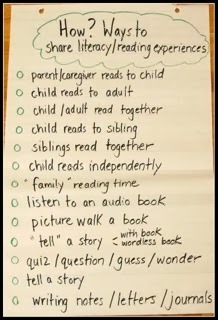
Months later, I am still hearing from parents about how this workshop has helped them support their child.
"Thank you for saying that rereading favorite books is okay. My son and I have stopped arguing about reading harder books and started snuggling and laughing through picture books we love."
"This made me excited to find books to share with my daughter. We listen to books as we make dinner. We now go to the library every week."
I plan to continue giving these literacy workshops at my school. It is such a fantastic way to really honor the importance of the home/school partnership in raising readers.
Carrie, this is a fabulous idea and one that seems doable. Drawing on my past experience with PTA, it seems like that sort of organization could be called on to help plan and support such a workshop. Thank you for going the extra mile to build solid reading habits.
Published on February 11, 2014 05:30
February 8, 2014
Saturday Surprise
I am giddy over this:
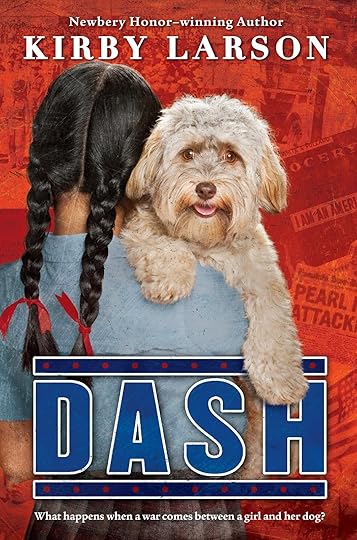
So excited that I've been given the okay for this cover reveal (Dash will pub in Fall 2014; Scholastic).
The working title of this manuscript was Love, Mitsi, which I loved. However, once Duke was published, it seemed this companion book should have a more. . . companionable title. I thought -- briefly! -- about using the name of Mitsi Shiraishi's dog (Mitsi was the inspiration for the new book) but my editor wasn't crazy about Chubby for a title. And who can blame her?
Our hero was called many things, including Blaze and Rusty, before we settled on Dash. And how perfect that using this name honors my good friend and writing buddy Mary Nethery (Dash is her beloved cat/muse).
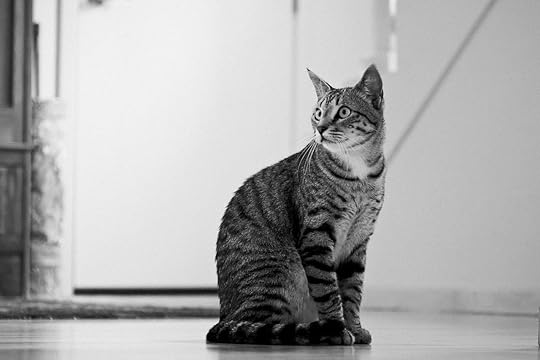 Dashiell Nethery, lost in thought
Dashiell Nethery, lost in thought
I think both the new title and the cover are purrrfect!

So excited that I've been given the okay for this cover reveal (Dash will pub in Fall 2014; Scholastic).
The working title of this manuscript was Love, Mitsi, which I loved. However, once Duke was published, it seemed this companion book should have a more. . . companionable title. I thought -- briefly! -- about using the name of Mitsi Shiraishi's dog (Mitsi was the inspiration for the new book) but my editor wasn't crazy about Chubby for a title. And who can blame her?
Our hero was called many things, including Blaze and Rusty, before we settled on Dash. And how perfect that using this name honors my good friend and writing buddy Mary Nethery (Dash is her beloved cat/muse).
 Dashiell Nethery, lost in thought
Dashiell Nethery, lost in thoughtI think both the new title and the cover are purrrfect!
Published on February 08, 2014 05:30



